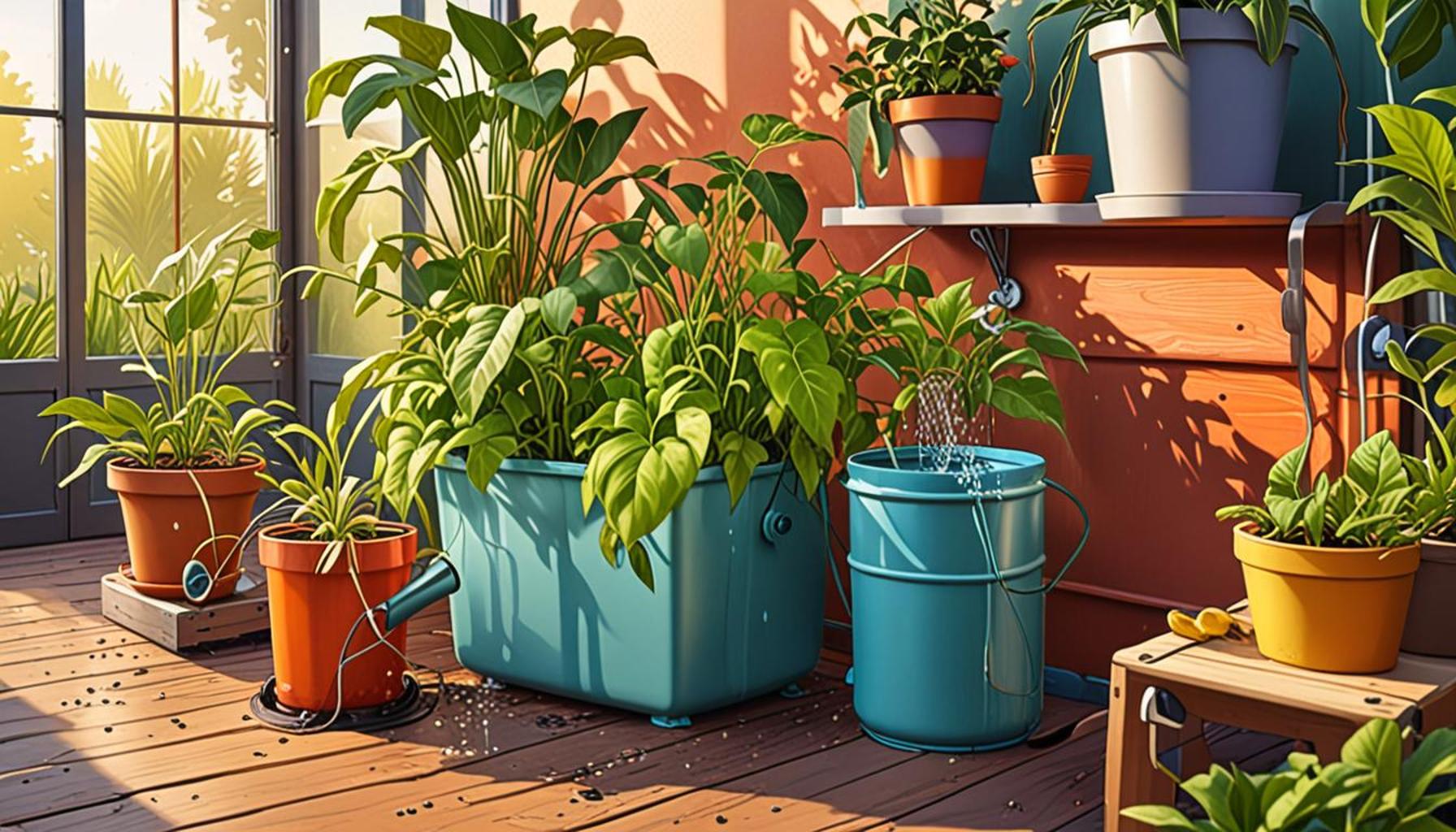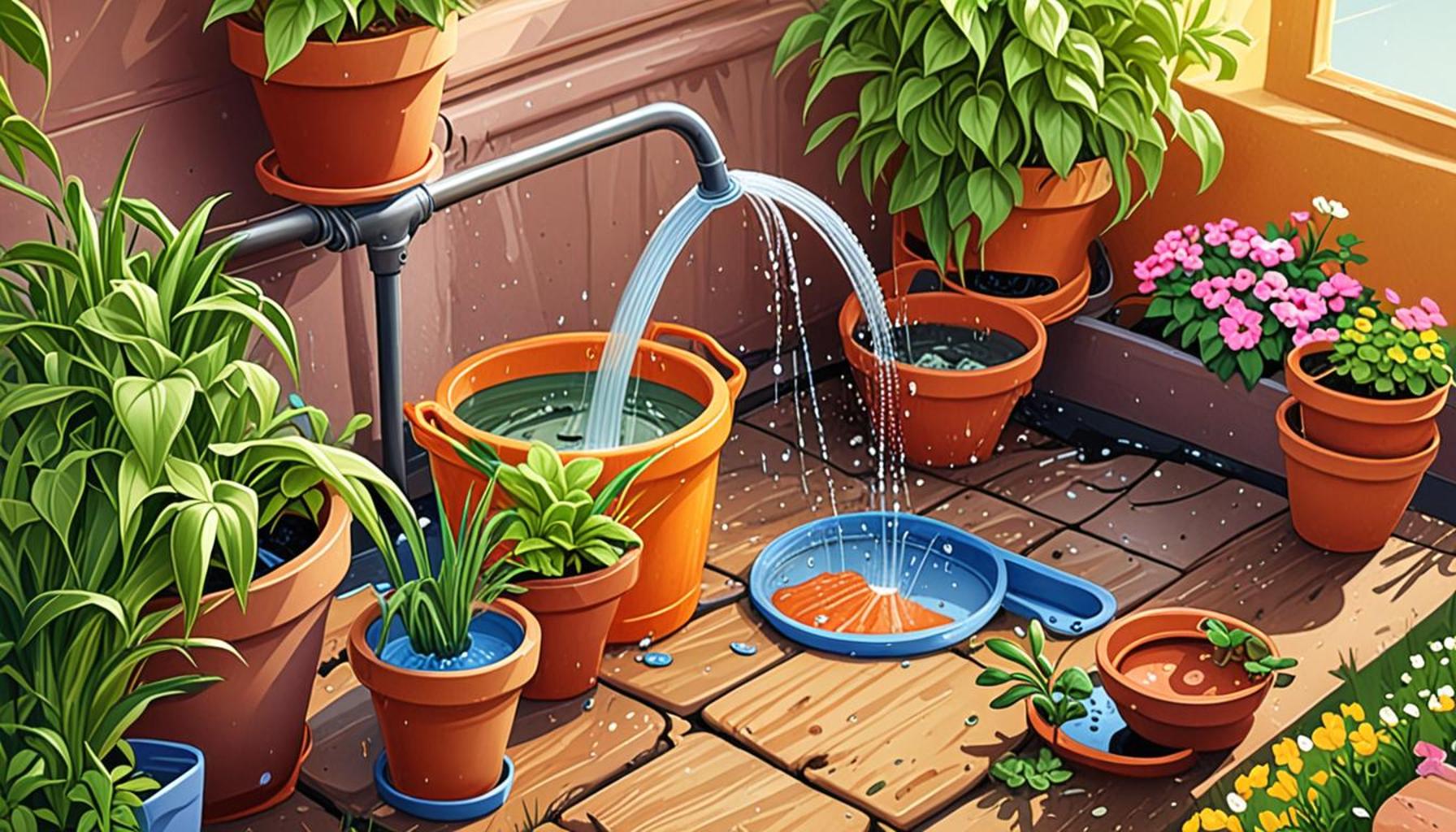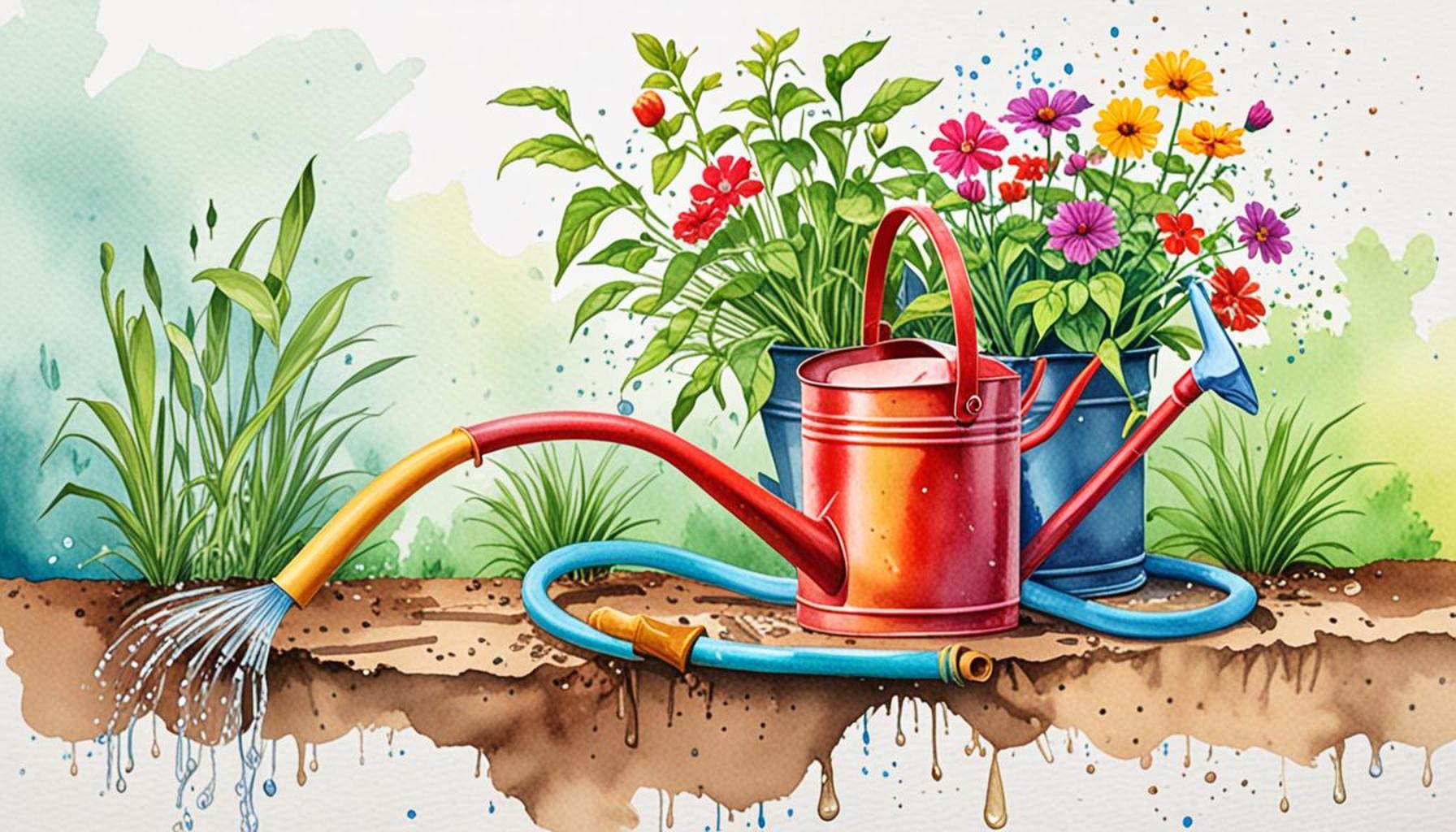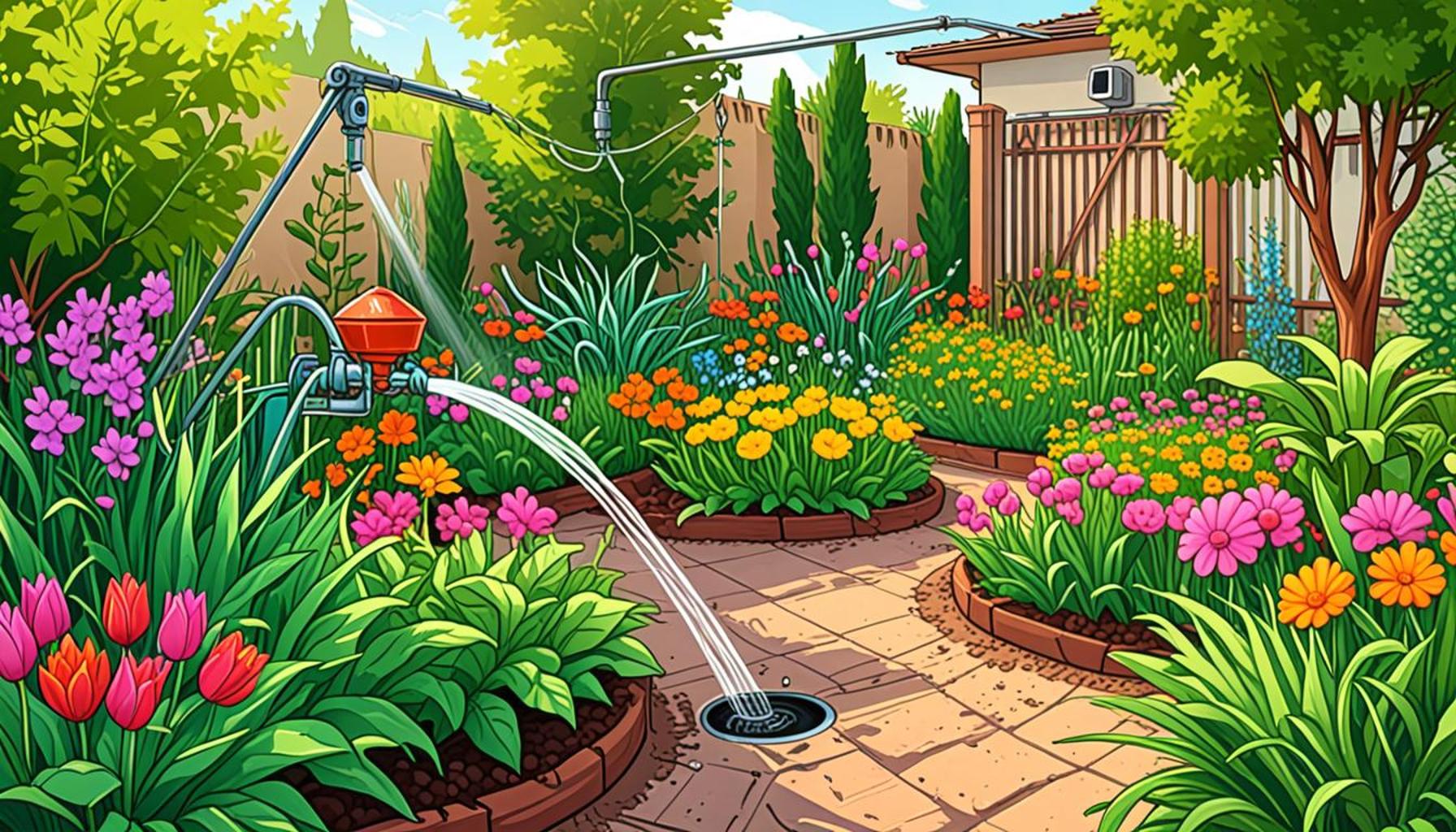Irrigation Techniques with Containers: How to Create a Self-Watering System for Houseplants

Understanding Self-Watering Systems
In the realm of horticulture, keeping your plants suitably hydrated can often feel like a juggling act, especially for urban dwellers with busy lifestyles. Self-watering systems offer a practical solution that not only optimizes water usage but also enhances the overall vitality of your plants. By providing a steady moisture supply, these irrigation techniques can revolutionize the way you care for your indoor garden.
Wicking Systems
One of the simplest self-watering methods is the wicking system. This ingenious setup uses a wick—typically a piece of absorbent material that stays in contact with both water and the soil. The wick draws water up from a reservoir and into the soil through capillary action. This method allows plants to access moisture on an as-needed basis, reducing the frequency of watering.
For example, a straightforward DIY wicking system can be created using a small container filled with water, a wick made from cotton or polyester, and a planter filled with potting soil. This approach not only conserves water but also helps prevent overwatering, making it perfect for those who may forget to water regularly.
Sub-Irrigation Planters
Another popular technique is the sub-irrigation planter, which features a built-in water reservoir at the bottom of the pot. This design allows plants to absorb water through their drainage holes as needed. Various commercial self-watering pots mimic this system, combining aesthetics with functionality. A classic example is the popular Lechuza planters, known for their sleek designs and efficient watering mechanisms.
When using sub-irrigation planters, it’s crucial to monitor the water level in the reservoir, especially during hot weather when plants may take up more moisture. This method not only encourages healthy root growth but also enhances the overall resilience of your plants.
Drip Irrigation
The third method worth exploring is drip irrigation, a more sophisticated solution widely used in both home gardening and agriculture. This method employs a network of tubes and emitters that deliver water precisely where it is needed—right at the root zone. Gardeners can customize their setups, adjusting the flow rate and emitter placements based on each plant’s unique requirements.
In urban settings, where space is at a premium, drip irrigation can maximize efficiency as it minimizes water waste and allows for better control of the moisture levels. Simple systems can be found at gardening stores or assembled from materials at home, making them accessible to all gardeners.
Overall, the implementation of these self-watering techniques leads to healthier houseplants thriving with minimal effort. The risk of problems associated with overwatering, such as root rot and fungal diseases, is significantly reduced, which can lead to a more successful gardening experience.
Conclusion
As we explore the intricacies of self-watering systems, you’ll uncover valuable insights into the advantages of each method and tips for crafting your own self-watering containers. This exploration opens the door to transforming your indoor space into a lush garden that flourishes with ease, empowering both novice and seasoned gardeners alike to maintain vibrant and healthy plant life. Step into the world of self-watering systems and watch your houseplants thrive effortlessly.
LEARN MORE: Click here for insights on sustainable growth
Exploring the Benefits of Self-Watering Systems
The art of gardening, whether indoors or outdoors, has long been cherished for its therapeutic effects and the beauty it adds to our spaces. One challenge many faces, however, is the maintenance aspect—particularly when it comes to watering plants. Self-watering systems provide an innovative solution that not only simplifies the watering process but also nurtures plant health in significant ways. By using these systems, both novice gardeners and seasoned horticulturists can enjoy flourishing plants while minimizing the demands on their time and resources.
Advantages of Self-Watering Systems
Incorporating self-watering containers into your gardening arsenal can enhance your indoor experience remarkably. From ensuring the optimal moisture levels to conserving water, the advantages are plentiful:
- Consistent Moisture Levels: Self-watering systems maintain stable moisture conditions, preventing the extremes of drought and over-saturation. This consistent hydration is a boon for root systems, which thrive when they can absorb water steadily.
- Reduced Maintenance: With these systems, the frequency of watering decreases significantly. Busy lifestyles can lead to missed watering sessions, but self-watering systems provide a natural solution to keep plants hydrated, allowing for more leisurely enjoyment of gardening.
- Minimized Water Waste: In an age where water conservation is critical—especially in many regions across the United States affected by drought—self-watering systems utilize water more efficiently. They reduce runoff and evaporation, making them an eco-friendly choice for environmentally conscious gardeners.
- Improved Plant Growth: Adequate water levels enhance the ability of plants to absorb nutrients, leading to denser foliage and vibrant blooms. When plants have access to the right amount of moisture consistently, they can grow more robustly without the stress of fluctuating hydration levels.
The highlighted benefits showcase why self-watering systems cater not only to plants’ needs but also fit seamlessly into the busy lifestyles of urban gardeners. With less time spent on maintenance, gardeners can focus on other aspects of cultivation, such as selecting the right varieties or experimenting with new arrangements.
Materials for Building Your Own System
For those who enjoy hands-on projects, creating a DIY self-watering system can be both rewarding and educational. To embark on this endeavor, gather the following essential materials:
- Containers: Choose a container that suits your style—options abound in plastic, ceramic, or metal. Ensure it can accommodate a reservoir at the base to hold water.
- Wicking Materials: Utilize natural fibers such as cotton or jute for optimum moisture transfer. These materials draw water upward through capillary action, effectively acting as a delivery system for your plants.
- Soil and Fertilizer: Opt for a high-quality potting mix that balances aeration and moisture retention while providing essential nutrients. A well-prepared medium boosts plant health and growth.
- Watering Tray or Reservoir: This key component sits at the base of your container, holding the water supply needed for your plants. It should be large enough to provide a sufficient reservoir for your specific plants’ needs.
By understanding and gathering these materials, you’re poised to create a self-watering system that not only supports plant growth but also contributes to a sustainable approach to plant care.
Diving into the world of self-watering systems illuminates pathways for a more manageable and rewarding indoor gardening experience. Embracing these innovative techniques means transforming your houseplant care routine into a less stressful hobby, fostering not just vibrant greenery but also a thriving indoor oasis.
Irrigation Techniques with Containers: How to Create a Self-Watering System for Houseplants
Creating a self-watering system for your houseplants provides an array of benefits that can simplify your plant care routine while ensuring optimal growth. By understanding the details behind these systems, you can transform your approach to indoor gardening.
| Advantages | Key Features |
|---|---|
| Consistent Moisture Levels | Self-watering systems ensure that the soil remains evenly moist, preventing episodes of root rot and promoting healthy growth. |
| Reduced Maintenance | Less frequent watering is necessary, providing busy plant owners peace of mind and saving time while ensuring their plants thrive. |
One effective way to set up a self-watering system is by using a two-container method. In this approach, a reservoir can be created using a larger pot at the base, while a smaller pot holds the plants. Wicking materials, such as cotton or specialized wicking cords, draw water from the reservoir to the soil, delivering hydration directly to the roots as needed.
This system not only simplifies watering routines but also allows you to engage more deeply in the care of each plant. It can be particularly beneficial for tropical plants or varieties that require consistent humidity. The key to success lies in choosing the right materials for construction, such as moisture-retentive potting mixes and appropriate wicking elements.
As you explore the various irrigation techniques available for houseplants, consider how you can create a customized self-watering setup that fits your lifestyle and plant preferences. With dedication to proper construction and maintenance, you’ll cultivate a thriving indoor garden that flourishes effortlessly.
DON’T MISS: Click here for effective pot irrigation techniques
Designing Your Self-Watering Container
Once you’ve gathered the necessary materials, the next step is to design and assemble your self-watering container. The efficient operation of these systems relies not only on the materials selected but also on how they are structured. This guide will illuminate the design principles that ensure your self-watering system functions effectively, delivering continuous moisture to your houseplants while minimizing the risk of over-saturation.
Basic Structure of a Self-Watering Container
The fundamental structure of a self-watering container consists of two main components: the upper planting area and the lower water reservoir. To create a functional design, follow these crucial steps:
- Drilling Drainage Holes: The upper part of your container (where plants will grow) should have drainage holes to allow excess water to escape. These holes should be situated at the base of the container above the water reservoir. This setup ensures that the roots can absorb water through the wicking material once the moisture levels start to drop.
- Creating a Wicking System: Cut wicking material—such as cotton strips or jute rope—and insert one end into the upper planting area, allowing it to dangle into the reservoir below. This design will facilitate capillary action, drawing water up from the reservoir to keep the soil consistently moist without flooding.
- Layering Soil: Begin with a layer of gravel or small rocks at the bottom of the upper section to enhance drainage. Following that, fill the container with high-quality potting mix that allows for good aeration. Ensure the soil doesn’t become compacted, as this can hinder the transfer of moisture.
Choosing Plants for Your Self-Watering System
Not all plants will thrive in a self-watering setup, so it’s essential to choose varieties that benefit from consistent moisture. Consider the following types of plants that flourish in self-watering containers:
- Herbs: Herbs such as basil, mint, and parsley benefit immensely from regular moisture, helping to enhance their flavors and growth.
- Houseplants: Popular houseplants like pothos, snake plants, and peace lilies thrive in self-watering systems due to their preference for steadily moist conditions.
- Vegetable Starts: For those looking to grow vegetables indoors, seedlings such as tomatoes and peppers flourish when the moisture levels are stable during their crucial growing phases.
When choosing plants for your self-watering containers, consider their individual moisture and light requirements, ensuring that they align with the environment of your home. Grouping plants with similar care needs can further simplify your indoor gardening routine.
Monitoring and Adjusting the System
While self-watering systems significantly reduce maintenance needs, regular monitoring is still crucial. Keep an eye on the water levels in the reservoir, as some plants may absorb more moisture than others. Additionally, check the upper soil periodically to ensure it maintains the right balance of moisture. Here are a few tips:
- Visual Checks: Observe the leaves of your plants for signs of either over-watering—such as yellowing leaves—or under-watering—like wilting or browning tips. Both can indicate necessary adjustments to your watering approach.
- Fertilizer Considerations: Since self-watering containers maintain soil moisture, nutrient leaching can occur if plants are watered too frequently. Adjust feeding schedules accordingly, ensuring your plants receive adequate nutrients without over-saturating the soil.
- Seasonal Adjustments: During cooler months or lower light conditions, plants may require less water. Adjust the reservoir’s water level accordingly, ensuring that plants still receive sustenance without excess moisture.
These strategies will help maintain an optimal growing environment for your houseplants. With a well-designed self-watering system, you not only promote healthy growth but also enjoy the many benefits that come with sustainable gardening practices.
LEARN MORE: Click here to find out how to protect your crop</a
Conclusion
In conclusion, developing a self-watering system for your houseplants is an innovative and effective way to enhance your indoor gardening experience. By integrating efficient irrigation techniques with containers, you can create a sustainable growing environment that minimizes the need for constant maintenance while ensuring your plants receive the moisture they need to thrive. The design principles of a self-watering container, such as incorporating drainage holes, using a well-structured wicking system, and selecting the right soil mix, are all crucial elements that contribute to the success of this gardening method.
Moreover, recognizing the right plants for your self-watering system allows you to cultivate a variety of herbs, houseplants, and vegetable starts that will flourish in a consistently moist setting. Regular monitoring and making adjustments based on water levels and seasonal changes further promote healthy growth, transforming your indoor space into a verdant oasis.
As you explore these techniques and implement your self-watering containers, consider the broader impact of sustainable gardening practices. Not only can you enjoy the beauty of thriving plants in your home, but you also contribute to a more ecologically responsible approach to gardening. So, dive into the world of self-watering systems, and discover the joy and resilience they bring to your houseplants while freeing up your time for what truly matters – nurturing your green thumb.


